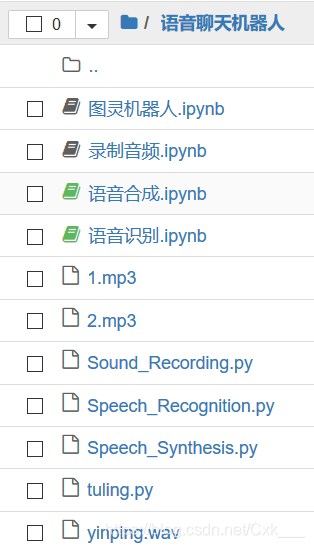目录
1.调用playsound库进行播放音频时会出现使用后资源不释放产生以下错误:
PermissionError: [Errno 13] Permission denied: “1.MP3”
解决办法参考以下:https://blog.csdn.net/liang4000/article/details/96766845
-
项目构想
录制一段音频并识别成字符,将字符传入图灵机器人并获得回复,将回复合成音频文件并播放。
-
项目感想
讯飞语音识别率还行,但是项目容错率低,并且项目基本调用API,没进一步研究语音识别技术的过程与实现,不过还是颇有收获,学习到了完成项目期间出现各种各样的问题的解决办法,所以只要你敢想,敢动手去做就一定会有收获。
-
项目API调用
讯飞语音识别,百度语音合成,图灵机器人。
-
项目语言以及库
Python+playsound+pyaudio+wave+os+百度API+讯飞API+图灵机器人API。
-
项目目录

-
文件构成
中文目录:语音识别为主函数----->>函数调用步骤(1.语音录制 2.语音识别 3.图灵机器人 4.语音合成)
英文目录:Speech_Recognition.py----->>(1. Sound_Recording.py 2.Speech_Recognition.py 3.tuling.py 4.Specch_Sythesis.py)
-
代码清单
main:2.Speech_Recognition.py
#!/usr/bin/env python
# -*- coding: utf-8 -*-
# @Time : 2019/12/27 16:10
# @Author : Cxk
# @File : Speech_Recognition.py
# -*- coding:utf-8 -*-
#
# author: iflytek
#
# 本demo测试时运行的环境为:Windows + Python3.7
# 本demo测试成功运行时所安装的第三方库及其版本如下,您可自行逐一或者复制到一个新的txt文件利用pip一次性安装:
# cffi==1.12.3
# gevent==1.4.0
# greenlet==0.4.15
# pycparser==2.19
# six==1.12.0
# websocket==0.2.1
# websocket-client==0.56.0
#
# 语音听写流式 WebAPI 接口调用示例 接口文档(必看):https://doc.xfyun.cn/rest_api/语音听写(流式版).html
# webapi 听写服务参考帖子(必看):http://bbs.xfyun.cn/forum.php?mod=viewthread&tid=38947&extra=
# 语音听写流式WebAPI 服务,热词使用方式:登陆开放平台https://www.xfyun.cn/后,找到控制台--我的应用---语音听写(流式)---服务管理--个性化热词,
# 设置热词
# 注意:热词只能在识别的时候会增加热词的识别权重,需要注意的是增加相应词条的识别率,但并不是绝对的,具体效果以您测试为准。
# 语音听写流式WebAPI 服务,方言试用方法:登陆开放平台https://www.xfyun.cn/后,找到控制台--我的应用---语音听写(流式)---服务管理--识别语种列表
# 可添加语种或方言,添加后会显示该方言的参数值
# 错误码链接:https://www.xfyun.cn/document/error-code (code返回错误码时必看)
# # # # # # # # # # # # # # # # # # # # # # # # # # # # # # # # # # # # # # # # # # # # # # # # # # # # # # # # # # # #
import websocket
import datetime
import hashlib
import base64
import hmac
import json
from urllib.parse import urlencode
import time
import ssl
from wsgiref.handlers import format_date_time
from datetime import datetime
from time import mktime
import _thread as thread
from Speech_Synthesis import *
from tuling import *
from Sound_Recording import *
from playsound import playsound
import os
STATUS_FIRST_FRAME = 0 # 第一帧的标识
STATUS_CONTINUE_FRAME = 1 # 中间帧标识
STATUS_LAST_FRAME = 2 # 最后一帧的标识
class Ws_Param(object):
# 初始化
def __init__(self, APPID, APIKey, APISecret, AudioFile):
self.APPID = APPID
self.APIKey = APIKey
self.APISecret = APISecret
self.AudioFile = AudioFile
# 公共参数(common)
self.CommonArgs = {"app_id": self.APPID}
# 业务参数(business),更多个性化参数可在官网查看
self.BusinessArgs = {"domain": "iat", "language": "zh_cn", "accent": "mandarin", "vinfo":1,"vad_eos":10000}
# 生成url
def create_url(self):
url = 'wss://ws-api.xfyun.cn/v2/iat'
# 生成RFC1123格式的时间戳
now = datetime.now()
date = format_date_time(mktime(now.timetuple()))
# 拼接字符串
signature_origin = "host: " + "ws-api.xfyun.cn" + "\n"
signature_origin += "date: " + date + "\n"
signature_origin += "GET " + "/v2/iat " + "HTTP/1.1"
# 进行hmac-sha256进行加密
signature_sha = hmac.new(self.APISecret.encode('utf-8'), signature_origin.encode('utf-8'),
digestmod=hashlib.sha256).digest()
signature_sha = base64.b64encode(signature_sha).decode(encoding='utf-8')
authorization_origin = "api_key=\"%s\", algorithm=\"%s\", headers=\"%s\", signature=\"%s\"" % (
self.APIKey, "hmac-sha256", "host date request-line", signature_sha)
authorization = base64.b64encode(authorization_origin.encode('utf-8')).decode(encoding='utf-8')
# 将请求的鉴权参数组合为字典
v = {
"authorization": authorization,
"date": date,
"host": "ws-api.xfyun.cn"
}
# 拼接鉴权参数,生成url
url = url + '?' + urlencode(v)
# print("date: ",date)
# print("v: ",v)
# 此处打印出建立连接时候的url,参考本demo的时候可取消上方打印的注释,比对相同参数时生成的url与自己代码生成的url是否一致
# print('websocket url :', url)
return url
# 收到websocket消息的处理
def on_message(ws, message):
global result
try:
code = json.loads(message)["code"]
sid = json.loads(message)["sid"]
if code != 0:
errMsg = json.loads(message)["message"]
print("sid:%s call error:%s code is:%s" % (sid, errMsg, code))
else:
data = json.loads(message)["data"]["result"]["ws"]
for i in data:
for w in i["cw"]:
result += w["w"]
# print("sid:%s call success!,data is:%s" % (sid, json.dumps(data, ensure_ascii=False)))
except Exception as e:
print("receive msg,but parse exception:", e)
return '识别出错!'
# 收到websocket错误的处理
def on_error(ws, error):
print("### error:", error)
# 收到websocket关闭的处理
def on_close(ws):
print("### closed ###")
# 收到websocket连接建立的处理
def on_open(ws):
def run(*args):
frameSize = 8000 # 每一帧的音频大小
intervel = 0.04 # 发送音频间隔(单位:s)
status = STATUS_FIRST_FRAME # 音频的状态信息,标识音频是第一帧,还是中间帧、最后一帧
with open(wsParam.AudioFile, "rb") as fp:
while True:
buf = fp.read(frameSize)
# 文件结束
if not buf:
status = STATUS_LAST_FRAME
# 第一帧处理
# 发送第一帧音频,带business 参数
# appid 必须带上,只需第一帧发送
if status == STATUS_FIRST_FRAME:
d = {"common": wsParam.CommonArgs,
"business": wsParam.BusinessArgs,
"data": {"status": 0, "format": "audio/L16;rate=16000",
"audio": str(base64.b64encode(buf), 'utf-8'),
"encoding": "raw"}}
d = json.dumps(d)
ws.send(d)
status = STATUS_CONTINUE_FRAME
# 中间帧处理
elif status == STATUS_CONTINUE_FRAME:
d = {"data": {"status": 1, "format": "audio/L16;rate=16000",
"audio": str(base64.b64encode(buf), 'utf-8'),
"encoding": "raw"}}
ws.send(json.dumps(d))
# 最后一帧处理
elif status == STATUS_LAST_FRAME:
d = {"data": {"status": 2, "format": "audio/L16;rate=16000",
"audio": str(base64.b64encode(buf), 'utf-8'),
"encoding": "raw"}}
ws.send(json.dumps(d))
time.sleep(1)
break
# 模拟音频采样间隔
time.sleep(intervel)
ws.close()
thread.start_new_thread(run, ())
def play(file):
playsound("%s"%file)
if __name__ == "__main__":
while(True):
"""
录音
参数 1 音频文件
参数 2 录音时长 单位(秒)
"""
audio_record("yinping.wav", 5)
"""
讯飞音频识别
APPID=ID,
APIKey=KEY,
APISecret=Secret,
AudioFile=音频文件
全局变量result:拼接返回结果
"""
global result
result=''
time1 = datetime.now()
wsParam = Ws_Param(APPID='申请的讯飞ID', APIKey='申请的讯飞KEY',
APISecret='申请的讯飞Secret',
AudioFile=r'yinping.wav')
websocket.enableTrace(False)
wsUrl = wsParam.create_url()
ws = websocket.WebSocketApp(wsUrl, on_message=on_message, on_error=on_error, on_close=on_close)
ws.on_open = on_open
ws.run_forever(sslopt={"cert_reqs": ssl.CERT_NONE})
time2 = datetime.now()
print("录音音频识别结果:"+result)
if("退出"in result):
"""
退出死循环
说关键词:退出
"""
print("程序已退出!!")
play("2.mp3")
break
else:
"""
图灵机器人回复
tuling(参数)
参数:讯飞音频识别回传字符串
百度语音合成
getBaiduVoice(参数)
参数:图灵机器人回传字符串
结果:合成音频文件1.MP3
"""
strss=tuling(result)
getBaiduVoice(strss)
"""
播放图灵机器人合成语音1.MP3
"""
play("1.mp3")
print("-------------------")
continue1. Sound_Recording.py
#!/usr/bin/env python
# -*- coding: utf-8 -*-
# @Time : 2019/12/27 18:18
# @Author : Cxk
# @File : Sound_Recording.py
import pyaudio
import os
import wave
# 用Pyaudio库录制音频
# out_file:输出音频文件名
# rec_time:音频录制时间(秒)
def audio_record(out_file, rec_time):
CHUNK = 1024
FORMAT = pyaudio.paInt16 #16bit编码格式
CHANNELS = 1 #单声道
RATE = 16000 #16000采样频率
p = pyaudio.PyAudio()
# 创建音频流
stream = p.open(format=FORMAT, # 音频流wav格式
channels=CHANNELS, # 单声道
rate=RATE, # 采样率16000
input=True,
frames_per_buffer=CHUNK)
print("开始录音...")
frames = [] # 录制的音频流
# 录制音频数据
for i in range(0, int(RATE / CHUNK * rec_time)):
data = stream.read(CHUNK)
frames.append(data)
# 录制完成
stream.stop_stream()
stream.close()
p.terminate()
print("录音完毕...")
# 保存音频文件
wf = wave.open(out_file, 'wb')
wf.setnchannels(CHANNELS)
wf.setsampwidth(p.get_sample_size(FORMAT))
wf.setframerate(RATE)
wf.writeframes(b''.join(frames))
wf.close()
# audio_record("yinping.wav", 5)
3.tuling.py
#!/usr/bin/env python
# -*- coding: utf-8 -*-
# @Time : 2019/12/27 17:50
# @Author : Cxk
# @File : tuling.py
import requests
import json
def tuling(info):
appkey = "申请的图灵机器人KEY"
url = "http://www.tuling123.com/openapi/api?key=%s&info=%s"%(appkey,info)
req = requests.get(url)
content = req.text
data = json.loads(content)
answer = data['text']
print("图灵机器人回复:"+answer)
return answer
4.Specch_Sythesis.py
#!/usr/bin/env python
# -*- coding: utf-8 -*-
# @Time : 2019/12/27 19:38
# @Author : Cxk
# @File : Speech_Synthesis.py
from aip import AipSpeech
# import random
def getBaiduVoice(text):
""" 你的 APPID AK SK """
APP_ID = '申请的百度ID'
API_KEY = '申请的百度KEY'
SECRET_KEY = '申请的讯飞Secret'
client = AipSpeech(APP_ID, API_KEY, SECRET_KEY)
result = client.synthesis(text = text, options={'vol':5,'per':4})
if not isinstance(result,dict):
# i=random.randint(1,10)
with open('1.mp3','wb') as f:
f.write(result)
# return i
else:
print(result)
-
问题总结
1.调用playsound库进行播放音频时会出现使用后资源不释放产生以下错误:
PermissionError: [Errno 13] Permission denied: “1.MP3”
解决办法参考以下:https://blog.csdn.net/liang4000/article/details/96766845
2.仔细阅读各个API文档
3.如何退出死循环:添加if判断语音是否含有“退出”
if("退出"in result):
"""
退出死循环
说关键词:退出
"""
print("程序已退出!!")
play("2.mp3")
break-
项目视频展示
Python人工智障聊天机器人
